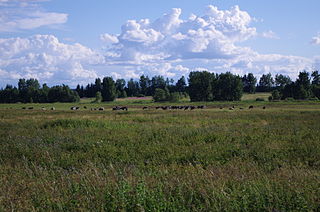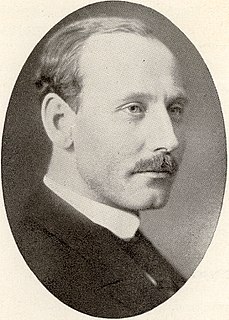
Tartu is the second-largest city in Estonia, after the political and financial capital, Tallinn. It is 186 kilometres southeast of Tallinn and 245 kilometres northeast of Riga, the capital of Latvia. Tartu lies on the Emajõgi, which connects the two largest lakes in Estonia, Lake Võrtsjärv and Lake Peipus. The city is served by Tartu Airport.

The University of Tartu is a university in the city of Tartu in Estonia. It is the national university of Estonia, and the only classical university in the country, and also its biggest and most prestigious university. It was founded under the name of Academia Gustaviana in 1632 by Baron Johan Skytte, the Governor-General (1629–1634) of Swedish Livonia, Ingria, and Karelia, with the required ratification provided by his long-time friend and former student – from age 7 –, King Gustavus Adolphus, shortly before the king's death on 6 November in the Battle of Lützen (1632), during the Thirty Years' War (1618–1648).

Viljandi County is one of 15 counties of Estonia. It is located in southern Estonia bordering Pärnu, Järva, Jõgeva, Tartu and Valga counties.

Tartu County is one of 15 counties of Estonia.

Kaarel Eenpalu was an Estonian journalist, politician and head of state, who served as 7th Prime Minister of Estonia.

Tartu Airport, is an airport in Reola, Ülenurme Parish, 5.9 nautical miles south southwest of Tartu, the second largest city in Estonia. It is also called Ülenurme Airport due to its proximity to the village of Ülenurme. The Tallinn–Tartu–Võru–Luhamaa highway (E263) passes near the airport.

Tamme Stadium is a multi-purpose stadium in Tartu, Estonia, located in the district of Tammelinn. It is currently used mostly for football matches and hosts the matches of Tammeka Tartu. The stadium holds 1,638 people.

The Treaty of Tartu is a peace treaty that was signed in Tartu on 2 February 1920 between the Republic of Estonia and Soviet Russia, ending the 1918–1920 Estonian War of Independence. In the treaty, Bolshevik Russia recognized the independence of the newly established democratic state of Estonia.

Tartu Parish is a rural municipality in Tartu County, Estonia. It has a population of 10,810 and covers an area of 742 km². The population density is 14.569/km2 (37.73/sq mi). It has four small boroughs and 39 villages.
University of Tartu basketball team, is a professional basketball team based in Tartu, Estonia. The team plays in the Latvian–Estonian Basketball League. They play their home games at the University of Tartu Sports Hall.
The Korvpalli Meistriliiga, known as the OlyBet Korvpalli Meistriliiga for sponsorship reasons, is the highest tier level and most important professional basketball league in Estonia. It is controlled by the Estonian Basketball Association.

Tartu Cathedral, earlier also known as Dorpat Cathedral, is a former Catholic church in Tartu (Dorpat), Estonia. The building is now an imposing ruin overlooking the lower town. In the small part of it that has been renovated is now located the museum of the University of Tartu, which the university also uses for major receptions.

Kiidjärve is a village in Põlva Parish, Põlva County in southeastern Estonia. It's located about 9 km (6 mi) north of the town of Põlva and about 30 km (19 mi) southeast of the city of Tartu, by the Tartu–Pechory railway and the Ahja River. The village territory includes Saesaare Reservoir with hydroelectric power station and Valgesoo bog.

Elistvere is a village in Tartu Parish, Tartu County, Estonia. It has a population of 44.

Ülenurme is a small borough in Tartu County, in Kambja Parish, in Estonia. It was the administrative centre of Ülenurme Parish. Ülenurme has a population of 1,574.

Raadi-Kruusamäe, or Raadi for short, is a neighbourhood of Tartu, Estonia. It has a population of 4,498 and an area of 2.83 km2 (1.09 sq mi). Raadi is mainly suburban area.

Kurista is a village in Kastre Parish, Tartu County, Estonia. It is located just southwest of Võnnu. The city of Tartu is located about 21 km (13 mi) northwest. In 2000 Kurista had a population of 135. Prior to the administrative reform of Estonian local governments in 2017, the village belonged to Võnnu Parish.

Alatskivi Castle is a Neo-Gothic castle in Alatskivi, Estonia. Dating to the 17th century, it is situated in Alatskivi Parish, Tartu County. It was rebuilt in the late 19th century by Baron Arved von Nolcken, modeled on the royal residence of Balmoral in Scotland. A renovation occurred between 2005 and 2011. Five rooms on the first floor house the Eduard Tubin museum, which documents his accomplishments as a music composer and conductor.

Raadi Manor was in the area known as Raadi-Kruusamäe, on the outskirts of Tartu in Estonia. The manor and Raadi Manor Park were the home to the Liphart noble family who were significant art collectors. The family moved away and the buildings housed the Estonian National Museum until the manor was destroyed during the Second World War. Part of the grounds became Raadi Airfield which was used as a secret Soviet bomber base for fifty years. Today the park is open, some buildings are in use by the museum and plans are underway to create a new museum building here.

















